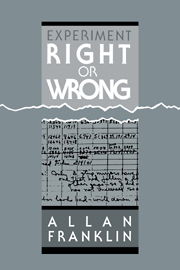Book contents
- Frontmatter
- Contents
- Preface
- Acknowledgments
- Introduction
- I EXPERIMENT AND THE DEVELOPMENT OF THE THEORY OF WEAK INTERACTIONS: FROM FERMI TO V-A
- 1 Fermi's theory
- 2 Toward a universal Fermi interaction; muons and pions
- 3 Beta-decay theory following World War II
- 4 The discovery of parity nonconservation
- 5 The V-A theory of weak interactions and its acceptance
- II TOWARD A PHILOSOPHY OF EXPERIMENT
- Conclusion
- Appendix
- References
- Index
3 - Beta-decay theory following World War II
Published online by Cambridge University Press: 15 September 2009
- Frontmatter
- Contents
- Preface
- Acknowledgments
- Introduction
- I EXPERIMENT AND THE DEVELOPMENT OF THE THEORY OF WEAK INTERACTIONS: FROM FERMI TO V-A
- 1 Fermi's theory
- 2 Toward a universal Fermi interaction; muons and pions
- 3 Beta-decay theory following World War II
- 4 The discovery of parity nonconservation
- 5 The V-A theory of weak interactions and its acceptance
- II TOWARD A PHILOSOPHY OF EXPERIMENT
- Conclusion
- Appendix
- References
- Index
Summary
As we saw in the last chapter, there was no generally agreed upon theory of muon decay processes in the early 1950s, although the decays were consistent with an STP combination. It was known that the coupling constants for those processes were approximately equal to those for nuclear β decay. This suggested the idea of a Universal Fermi Interaction that would apply to all weak interactions. The situation was quite different in the area of β-decay theory, where a consensus existed. In his 1943 review of the theory, Konopinski had noted the general support for Fermi's theory with a preference for the Gamow-Teller interaction involving the tensor (T) or axial vector (A) forms of the interaction. By the time of a 1953 review article by Konopinski and Langer, they stated, “As we shall interpret the evidence here, the correct law must be what is known as an STP combination” (1953, p. 261, emphasis added). In this section I will examine the evidence and arguments for this definite conclusion, which, as the subsequent history will show, was wrong, but not unreasonable.
There were several attempts, based on general theoretical principles, to reduce the arbitrariness of the forms of the interactions involved in β decay. Recall that Critchfield and Wigner (1941) and Critchfield (1943) had, on the basis of symmetry considerations, found that the antisymmetric sum of the S, A, and P forms would fit the data.
- Type
- Chapter
- Information
- Experiment, Right or Wrong , pp. 42 - 62Publisher: Cambridge University PressPrint publication year: 1990



